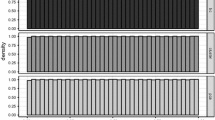Abstract
Both the efficient market hypothesis and modern portfolio theory rest on the assumptions of the Gaussian probability distribution and independence of consecutive returns. This paper provides a brief excursion into the history of capital market research. A measure of long-range dependence (Hurst exponent) was applied to daily returns of selected stock indices and individual firms. The Hurst exponent was estimated using rescaled range analysis. The estimates are based on an unusually large sample of empirical-time series from capital markets. This method distinguishes whether the data-generating process follows random walk or exhibits antipersistent or persistent behavior. Both the efficient market hypothesis and modern portfolio theory assume that the data-generating process has no memory, i.e. follows Brownian motion. The random walk process is characterized by a Hurst exponent value of 0.5. Values greater than 0.5 and less than 1 indicate a persistence of local trends. Values between 0 and 0.5 indicate a process that reverts to the mean more often than a random process (mean-reverting process). The results indicated that the series of daily returns exhibit predominantly persistent or antipersistent behavior. Therefore, Brownian motion cannot be perceived as the norm for describing stock market behavior. These findings challenge the assumption of a random walk in stock prices, valuation models and assessment of risk.



Similar content being viewed by others
References
Alessio, E., Carbone, A., Castelli, G., & Frappietro, V. (2002). Second-order moving average and scaling of stochastic time series. The European Physical Journal B, 27(2), 197–200.
Bachelier, L. (1900). The theory of speculation. Annales Scientifiques de l'École Normale Supérieure, 3(17), 21–86.
Barunik, J., & Krištoufek, L. (2010). On Hurst exponent estimation under heavy-tailed distributions. Physica A, 389, 3844–3855.
Beran, J. (1992). Statistical methods for data with long-range dependence. Statistical Science, 7(4), 404–427.
Black, F., & Scholes, M. (1973). The pricing of options and corporate liabilities. Journal of Political Economy, 81(3), 637–654.
Cheung, Y. W., & Lai, K. S. (1995). Lag order and critical values of the augmented Dickey-Fuller test. Journal of Business & Economic Statistics, 13(3), 277–280.
Dickey, D. A., & Fuller, W. A. (1979). Distribution of the estimators for autoregressive time series with a unit root. Journal of the American Statistical Association, 74(366), 427–431.
Fama, E. F. (1965). The behavior of stock-market prices. The Journal of Business, 38(1), 34–105.
Fama, E. F., & Blume, M. E. (1966). Filter rules and stock-market trading. The Journal of Business, 39(1), 226–241.
Fernández-Martínez, M., Sánchez-Granero, M. A., Muñoz Torrecillas, M. J., & McKelvey, B. (2017). A comparison of three Hurst exponent approaches to predict nascent bubbles in S&P500 stocks. Fractals, 25(1), 10.
Grech, D., & Mazur, Z. (2003). Can one make any crash prediction in finance using the local Hurst exponent idea? Physica A, 336, 133–145.
Krištoufek, L. (2010). Rescaled range analysis and Detrended fluctuation analysis: Finite sample properties and confidence intervals. AUCO Czech Economic Review, 4(3), 315–329.
Kwiatkowski, D., Phillips, P. C. B., Schmidt, P., & Shin, Y. (1992). Testing the null hypothesis of stationarity against the alternative of a unit root. Journal of Econometrics, 54, 159–178.
Mandelbrot, B. (1963). Statistical methodology for nonperiodic cycles: From the covariance to R/S analysis. Annals of Economic and Social Measurement, 1(3), 259–290.
Mandelbrot, B. (1971). Analysis of long-run dependence in economics: The R/S technique. Econometrica, 39, 68–69.
Mandelbrot, B. (1997). Fractals and scaling in finance: Discontinuity, concentration, risk. 1st ed. New York: Springer. ISBN 0-387-98363-5.
Mansukhani, S. (2012). The Hurst exponent: Predictability of time series. Analytics Magazine, 4, 29–31.
Morningstar (2017). Stocks. Available at morningstar.com.
Peng, C.-K., Buldyrev, S. V., Havlin, S., Simons, M., Stanley, H. E., & Goldberger, A. L. (1994). Mosaic organization of DNA nucleotides. Physical Review E, 49(2), 1685–1689.
Sharpe, W. F. (1964). Capital asset prices: A theory of market equilibrium under conditions of risk. The Journal of Finance, 19(3), 425–442.
Acknowledgments
Financial support was provided by the Internal Grant Agency of the Faculty of Economics and Management, Czech University of Life Sciences Prague, Kamýcká 129, 165 21, Prague 6 - Suchdol, Czech Republic (grant number 20171007).
Author information
Authors and Affiliations
Corresponding author
Additional information
Publisher’s Note
Springer Nature remains neutral with regard to jurisdictional claims in published maps and institutional affiliations.
Electronic Supplementary Material
ESM 1
(DOCX 289 kb)
Rights and permissions
About this article
Cite this article
Dittrich, L.O., Srbek, P. Is Violation of the Random Walk Assumption an Exception or a Rule in Capital Markets?. Atl Econ J 48, 491–501 (2020). https://doi.org/10.1007/s11293-020-09686-y
Accepted:
Published:
Issue Date:
DOI: https://doi.org/10.1007/s11293-020-09686-y




